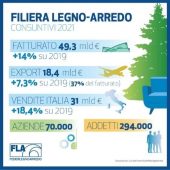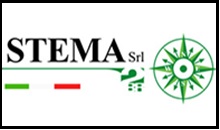The numbers capture the health of the wood-furniture supply chain in 2021 compared to 2019: plus 14.1 (with a production turnover of over 49 billion euros) compared to 43 in 2019. supply chain: plus 20.6 percent change over 2020; plus 7.3 percent on 2019 for a value of over 18 billion euros, which exceeds, albeit slightly, the 17 of 2019, consolidating a recovery in exports which account for over 37 percent of the entire sector. Looking at the Italian market, growth of 18.5 percent compared to 2019 and 28.9 percent on 2020 is recorded.
To say it are the Preliminary financial statements prepared by the FederlegnoArredo Study Center. Data that, after the 2020 decline, certify the return, indeed the overcoming of the pre-covid levels of the sector but, the expensive energy, the scarcity of raw materials, the costs of logistics and transport risk reversing the trend, already from the first months of 2022. And the winds of war that blow from Russia will only aggravate a situation that was already beginning to give some signs of malaise, not only on the export front but also for the supply of woody raw materials.
“Going from minus 9.1 percent in 2020 to 2019, to plus 25.7 percent by 2021 on 2020 to reach the double-digit result of 2021 is undoubtedly a prestigious goal that certifies how wood-furniture companies have respond better than others to the crisis of the last two years. And they did so by continuing to invest and innovate, interpreting with a constructive and positive spirit the health, social and economic drama that has affected the whole world. Despite this – comments Claudio Feltrin, president of FederlegnoArredo – now the critical and highly uncertain state due to the economic situation of the first months of 2022 prevails. We are facing a mix that really risks putting the hand brake on the recovery of the sector and we must be able to maintain growth at the levels of 2021, trusting that, as soon as possible, the calm will return“.
WOOD MACRO SYSTEM
Moving our gaze to the Wood Macro System, the 2021 preliminary results close with a plus 16.6 per cent compared to 2019 and a turnover of almost 20 billion euros (they were 17 in 2019) and a plus 29.1 per cent on 2020. For as regards sales on the Italian market, the sector stands at a plus 21.9 per cent on 2019 and a plus 32 per cent on 2020. Analyzing the export, which constitutes just under 25 per cent of the total turnover, the variation is by plus 2.5 per cent on 2019 and by plus 20.6 per cent on 2020. Exports to the main countries are growing: Germany, France, United Kingdom and the United States, while imports from Austria are also growing, Germany and China.
RUSSIA
The weight of Russia on the export of the wood-furniture chain is 410 million euros (data updated to November 2021) which in 2019 was 435, thus recording a decrease of about 6 percentage points.
The Macro furniture and lighting system, on the other hand, is worth around 340 million euros, which was 361 in 2019 with a decrease of around 6 percentage points also recorded in this case. In the export “ranking” of the Macro Furniture System, Russia is the 9th country, behind China, Spain and Belgium.
As far as imports are concerned, the wood and furniture supply chain weighs 136 million euros, registering an increase of 41.2 percent compared to 2019, above all demonstrating how much raw material we import from this country.
“A fact – explains Feltrin – that in the light of geopolitical developments can only make us raise our guard level, not only for the export of our products, but also for the imports of timber: Russia is an important supplier for our supply chain, which buys about eighty percent of the wood that it then processes abroad. The role of Russia is also fundamental to calm prices: if it blocks the sales of timber, as it had already started doing since January, this will push prices upwards even more. Countries like China, for example, are willing to pay any price to import wood. All this will cascade on the final consumer and undermine the competitiveness of our companies which will risk not being able to fulfill orders due to the lack of raw materials”.














